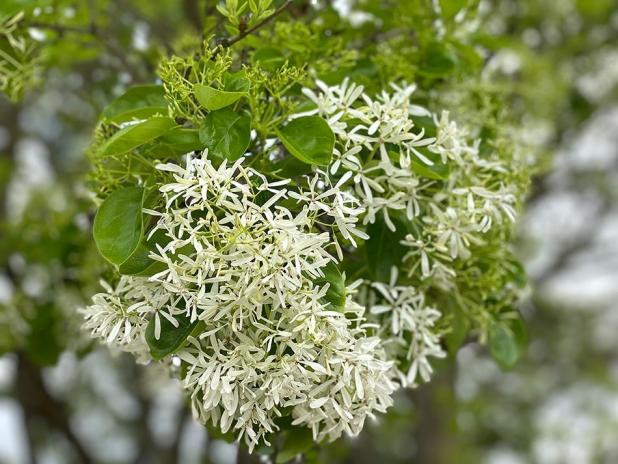
Fringe tree flowers grow in tight clusters of thin, white petals.
—LSU AgCenter/Heather Kirk-Ballard
Get It Growing: Add fringe, fragrance to landscape
March 19 marked the first day of spring this year, and all around us we see the signs of new life in our landscapes. Many plants are leafing out and blooming. The grass is once again greening, and all traces of dormancy and death are vanishing.
This time of year, one of the showiest spring-blooming trees is the fringe tree. Two species of fringe trees are most often seen in the landscape throughout the U.S.: the American fringe tree and Chinese fringe tree. Both are hardy throughout the South and northeastern United States.
The American fringe tree (Chionanthus virginicus) is a native of North America from Canada way down to the Gulf South. It can be found growing in the wild on the edge of woods, and it thrives in full sun to partial shade. The trees usually flourish in extremely wet river bottoms or in upland areas that are favorable to longleaf pine trees
Fringe trees produce clusters of white flowers spread all along their branches. The flowers are long and narrow, with green to white petals. The narrow hanging petals give the flowers a fringe or beardlike appearance, hence the common name of grancy greybeard or old man’s beard. Grancy is another word meaning grandpa or grandad.
The foliage of the American fringe tree is an attractive glossy green and begins to come out as the flowers have matured. Fall foliage color is bright yellow and a decent color change for the South. It can be used as a fall foliage focal point or spring-flowering specimen in the landscape.
The second species, the Chinese fringe tree (Chionanthus retusus), is a native of Asia. Chinese fringe trees range from Korea to Japan to China, but they also grow well in Louisiana. Chinese fringe tree flowers are showier than our native species. It is said that in China, the young leaves of the Chinese fringe tree are used as a tea substitute, and some are considered equal in fragrance to the best green teas.
Botanically, both species are deciduous shrubs. But if pruned properly when they are young, you can train them to one good trunk and encourage a tree form.
Chinese fringe trees grow in USDA hardiness zones 5 to 9 to a height of 10 to 20 feet tall by 10 to 20 feet wide. A slow-growing tree, it makes a fantastic specimen tree or foundation tree for around the house.
Trees bloom in early spring from March to April in full sun to partial shade. The flowers are showy and fragrant, and the bees just love them. The foliage of Chinese fringe tree is smaller, shinier and more leathery than the American fringe tree. They display a good fall leaf color change. If you enjoy a nice fragrance, the flowers can perfume your garden with their sweet, lilac-like smell.
Fringe trees are low-maintenance with medium watering requirements and few pest or disease problems. They also tolerate air pollution and adapt well to urban settings. However, they are not very drought tolerant. They will thrive in most landscape settings. The fringe tree is adaptable to a wide variety of soils, including clay or sandy soils that may pose problems for many other plants. They also like moist or wet soils and can be used in rain gardens or low-lying areas.
Fringe trees have male and female flowers on separate trees, with the male flowers being showier. Female flowers make clusters of olive-like fruits that ripen to a dark bluish black in late summer or early fall and are a good food source for birds and wildlife.
The Chinese fringe tree has a neater, more compact appearance, both in terms of its flowers and the overall tree, than the American fringe tree. The bark of mature Chinese fringe trees peel in gorgeous layers.
Fringe trees have no named cultivars. These plants are available in some local nurseries. The American fringe tree may be easier to find in nurseries offering native plant selections.
Grow these small, slow-growing trees in groups or as specimens in your landscape. They have a spectacular full bloom in spring that is sure to catch the eye of admirers. When it comes to spring-blooming trees, fringe tree is tougher than a dogwood, longer-lived than a cherry and almost as fragrant as sweet olive. Grab one if you fancy yourself something fringy and fragrant.
